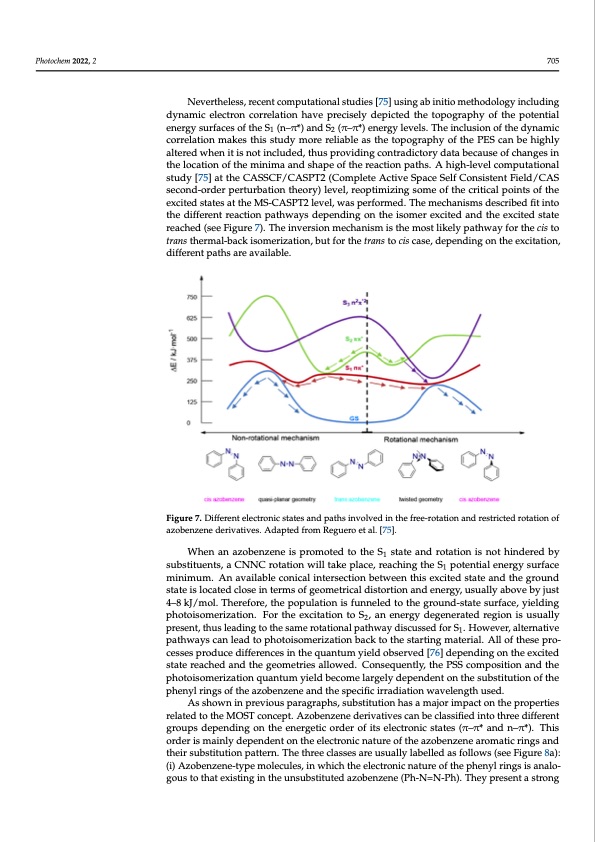
PDF Publication Title:
Text from PDF Page: 012
Photochem 2022, 2 705 Nevertheless, recent computational studies [75] using ab initio methodology including dynamic electron correlation have precisely depicted the topography of the potential energy surfaces of the S1 (n–π*) and S2 (π–π*) energy levels. The inclusion of the dynamic correlation makes this study more reliable as the topography of the PES can be highly altered when it is not included, thus providing contradictory data because of changes in the location of the minima and shape of the reaction paths. A high-level computational study [75] at the CASSCF/CASPT2 (Complete Active Space Self Consistent Field/CAS second-order perturbation theory) level, reoptimizing some of the critical points of the excited states at the MS-CASPT2 level, was performed. The mechanisms described fit into the different reaction pathways depending on the isomer excited and the excited state reached (see Figure 7). The inversion mechanism is the most likely pathway for the cis to trans thermal-back isomerization, but for the trans to cis case, depending on the excitation, different paths are available. Figure 7. Different electronic states and paths involved in the free-rotation and restricted rotation of azobenzene derivatives. Adapted from Reguero et al. [75]. When an azobenzene is promoted to the S1 state and rotation is not hindered by substituents, a CNNC rotation will take place, reaching the S1 potential energy surface minimum. An available conical intersection between this excited state and the ground state is located close in terms of geometrical distortion and energy, usually above by just 4–8 kJ/mol. Therefore, the population is funneled to the ground-state surface, yielding photoisomerization. For the excitation to S2, an energy degenerated region is usually present, thus leading to the same rotational pathway discussed for S1. However, alternative pathways can lead to photoisomerization back to the starting material. All of these pro- cesses produce differences in the quantum yield observed [76] depending on the excited state reached and the geometries allowed. Consequently, the PSS composition and the photoisomerization quantum yield become largely dependent on the substitution of the phenyl rings of the azobenzene and the specific irradiation wavelength used. As shown in previous paragraphs, substitution has a major impact on the properties related to the MOST concept. Azobenzene derivatives can be classified into three different groups depending on the energetic order of its electronic states (π–π* and n–π*). This order is mainly dependent on the electronic nature of the azobenzene aromatic rings and their substitution pattern. The three classes are usually labelled as follows (see Figure 8a): (i) Azobenzene-type molecules, in which the electronic nature of the phenyl rings is analo- gous to that existing in the unsubstituted azobenzene (Ph-N=N-Ph). They present a strongPDF Image | Overview of Molecular Solar Thermal Energy Storage

PDF Search Title:
Overview of Molecular Solar Thermal Energy StorageOriginal File Name Searched:
photochem-02-00045-v2.pdfDIY PDF Search: Google It | Yahoo | Bing
Turbine and System Plans CAD CAM: Special for this month, any plans are $10,000 for complete Cad/Cam blueprints. License is for one build. Try before you buy a production license. More Info
Waste Heat Power Technology: Organic Rankine Cycle uses waste heat to make electricity, shaft horsepower and cooling. More Info
All Turbine and System Products: Infinity Turbine ORD systems, turbine generator sets, build plans and more to use your waste heat from 30C to 100C. More Info
CO2 Phase Change Demonstrator: CO2 goes supercritical at 30 C. This is a experimental platform which you can use to demonstrate phase change with low heat. Includes integration area for small CO2 turbine, static generator, and more. This can also be used for a GTL Gas to Liquids experimental platform. More Info
Introducing the Infinity Turbine Products Infinity Turbine develops and builds systems for making power from waste heat. It also is working on innovative strategies for storing, making, and deploying energy. More Info
Need Strategy? Use our Consulting and analyst services Infinity Turbine LLC is pleased to announce its consulting and analyst services. We have worked in the renewable energy industry as a researcher, developing sales and markets, along with may inventions and innovations. More Info
Made in USA with Global Energy Millennial Web Engine These pages were made with the Global Energy Web PDF Engine using Filemaker (Claris) software.
Sand Battery Sand and Paraffin for TES Thermo Energy Storage More Info
| CONTACT TEL: 608-238-6001 Email: greg@infinityturbine.com | RSS | AMP |